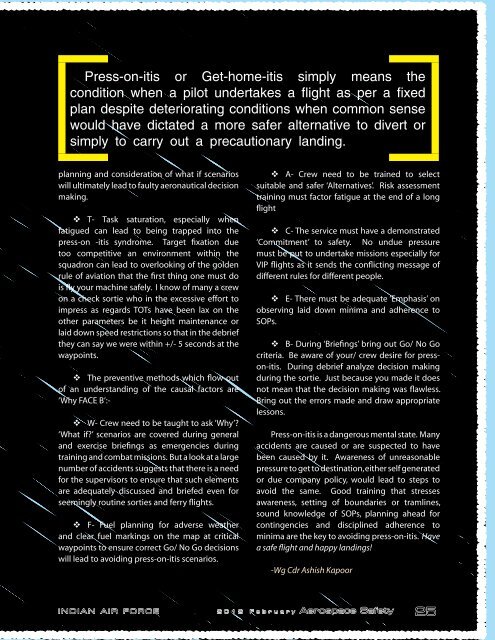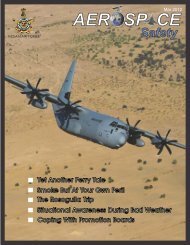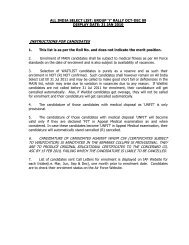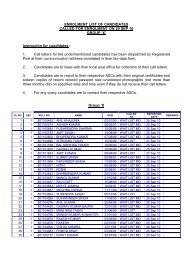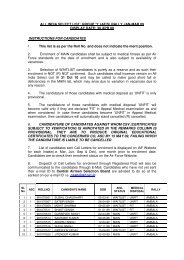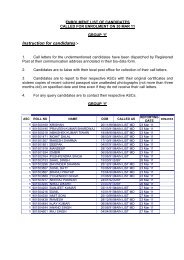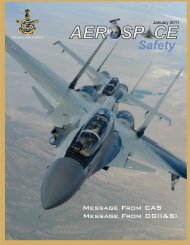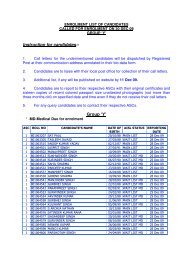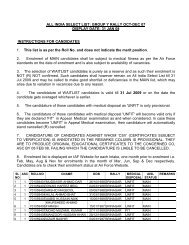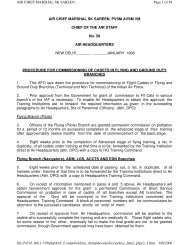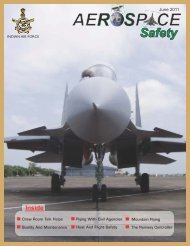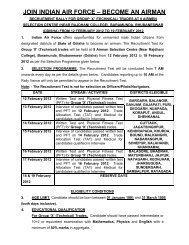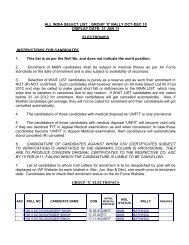final feb cover - Indian Airforce
final feb cover - Indian Airforce
final feb cover - Indian Airforce
Create successful ePaper yourself
Turn your PDF publications into a flip-book with our unique Google optimized e-Paper software.
Press-on-itis or Get-home-itis simply means the<br />
condition when a pilot undertakes a flight as per a fixed<br />
plan despite deteriorating conditions when common sense<br />
would have dictated a more safer alternative to divert or<br />
simply to carry out a precautionary landing.<br />
planning and consideration of what if scenarios<br />
will ultimately lead to faulty aeronautical decision<br />
making.<br />
T- Task saturation, especially when<br />
fatigued can lead to being trapped into the<br />
press-on -itis syndrome. Target fixation due<br />
too competitive an environment within the<br />
squadron can lead to overlooking of the golden<br />
rule of aviation that the first thing one must do<br />
is fly your machine safely. I know of many a crew<br />
on a check sortie who in the excessive effort to<br />
impress as regards TOTs have been lax on the<br />
other parameters be it height maintenance or<br />
laid down speed restrictions so that in the debrief<br />
they can say we were within +/- 5 seconds at the<br />
waypoints.<br />
The preventive methods which flow out<br />
of an understanding of the causal factors are<br />
‘Why FACE B’:-<br />
W- Crew need to be taught to ask ‘Why’<br />
‘What if’ scenarios are <strong>cover</strong>ed during general<br />
and exercise briefings as emergencies during<br />
training and combat missions. But a look at a large<br />
number of accidents suggests that there is a need<br />
for the supervisors to ensure that such elements<br />
are adequately discussed and briefed even for<br />
seemingly routine sorties and ferry flights.<br />
F- Fuel planning for adverse weather<br />
and clear fuel markings on the map at critical<br />
waypoints to ensure correct Go/ No Go decisions<br />
will lead to avoiding press-on-itis scenarios.<br />
A- Crew need to be trained to select<br />
suitable and safer ‘Alternatives’. Risk assessment<br />
training must factor fatigue at the end of a long<br />
flight<br />
C- The service must have a demonstrated<br />
‘Commitment’ to safety. No undue pressure<br />
must be put to undertake missions especially for<br />
VIP flights as it sends the conflicting message of<br />
different rules for different people.<br />
E- There must be adequate ‘Emphasis’ on<br />
observing laid down minima and adherence to<br />
SOPs.<br />
B- During ‘Briefings’ bring out Go/ No Go<br />
criteria. Be aware of your/ crew desire for presson-itis.<br />
During debrief analyze decision making<br />
during the sortie. Just because you made it does<br />
not mean that the decision making was flawless.<br />
Bring out the errors made and draw appropriate<br />
lessons.<br />
Press-on-itis is a dangerous mental state. Many<br />
accidents are caused or are suspected to have<br />
been caused by it. Awareness of unreasonable<br />
pressure to get to destination, either self generated<br />
or due company policy, would lead to steps to<br />
avoid the same. Good training that stresses<br />
awareness, setting of boundaries or tramlines,<br />
sound knowledge of SOPs, planning ahead for<br />
contingencies and disciplined adherence to<br />
minima are the key to avoiding press-on-itis. Have<br />
a safe flight and happy landings!<br />
-Wg Cdr Ashish Kapoor<br />
INDIAN AIR FORCE 2 0 1 2 F e b r u a r y Aerospace Safety 25


